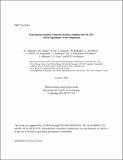| dc.description.abstract | This paper presents a dedicated study of plasma-antenna (PA) coupling with the Alfven Eigenmode Active Diagnostic (AEAD) in JET. Stable AEs and their resonant frequencies f, damping rates gamma < 0, and toroidal mode numbers n are measured for various PA separations and limiter versus X-point magnetic configurations. Two stable AEs are observed to be resonantly excited at distinct low and high frequencies in limiter plasmas. The values of f and n do not vary with PA separation. However, |gamma| increases with PA separation for the low-f, but not high-f, mode, yet this may be due to slightly different edge conditions. The high-f AE is detected throughout the transition from limiter to X-point configuration, though its damping rate increases; the low-f mode, on the other hand, becomes unidentifiable. The linear resistive MHD code CASTOR is used to simulate the frequency scan of an AEAD-like external antenna. For the limiter pulses, the high-f mode is determined to be an n = 0 GAE, while the low-f mode is likely an n = 2 TAE. During the transition from limiter to X-point configuration, CASTOR indicates that n = 1 and 2 EAEs are excited in the edge gap. These results extend previous experimental studies in JET and Alcator C-Mod; validate the computational work performed by Dvornova et al 2020 Phys. Plasmas 27 012507; and provide guidance for the optimization of PA coupling in upcoming JET energetic particle experiments, for which the AEAD will aim to identify the contribution of alpha particles to AE drive during the DT campaign. | |
